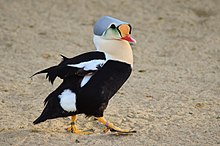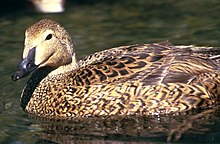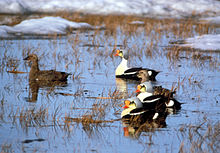King eider
| King eider | ||||||||||||
|---|---|---|---|---|---|---|---|---|---|---|---|---|

King eider ♂ ( Somateria spectabilis ) |
||||||||||||
| Systematics | ||||||||||||
|
||||||||||||
| Scientific name | ||||||||||||
| Somateria spectabilis | ||||||||||||
| ( Linnaeus , 1758) |

The Pracht eider ( Somateria spectabilis ), also King silk pension is a bird art from the genus of eider ( Somateria ) and the family of the Anatidae (Anatidae). The species, the males of which have an unmistakable splendor, breeds in a circumpolar manner on the coasts and islands of the northern Arctic Ocean. As with many Arctic bird species, the king eider population is subject to strong fluctuations. Overall, however, it is not considered to be endangered. During the winter months they are on the coasts of Scandinavia and Icelandto observe. On the coasts of the North and Baltic Seas , they can only be seen sporadically as stray visitors .
Appearance
Characteristics of adult king eiders
The king eider is somewhat smaller than the eider ( Somateria mollissima ) belonging to the same genus . The male, the drake, is unmistakable with its black body, white to salmon-colored breast and light blue upper head and neck. The neck feathers are slightly elongated, so that a spring hood appears. The most striking feature of the drake is the red upper beak, which has expanded to a frontal hump. It is set off from the light blue top of the head by a black feather wreath. The cheeks are sea green. The chin and throat are white. The black plumage of the rear part of the body is sharply defined by a narrow white side band and an almost round white spot on the rump sides. Sexually mature drakes, like females, have sickle-shaped curved inner arm wings. In the resting dress, the white feathers on the top of the head have been replaced by blackish brown ones. The sides of the head and the front breast are light cinnamon brown. The rest of the body plumage is dark brown to black brown.
The female has brown plumage. However, it can easily be distinguished from all ducks except for other eider ducks based on its size and build. Compared to the females of the eider, the plumage of the females of the king eider is more reddish, the beak is slightly shorter, and the body plumage is not banded, unlike that of the eider, but with the exception of the head, looks like scales. The chest and the underside of the body are black-brown. The beak and feet are green-brown in color. The iris is dirty yellow. The female's resting plumage resembles the breeding plumage. However, the color contrasts are somewhat weaker and the scale-like pattern of their body plumage is less noticeable.
Appearance of the young birds
Young female king eiders are already very similar in their plumage to the female king eiders. However, the stippling is still not very noticeable, and the feather hems lack the strong cinnamon brown that is characteristic of sexually mature females. Similar to the eider ducks, it takes a few years for the young drakes to fully develop their magnificent dress. The blue top of the head is still missing in the first splendid dress, and the white feathers are still interspersed with brown feathers. In the second splendid plumage the similarity to the splendid plumage of adult drakes is already passed on, but only in the third year does it resemble that of sexually mature birds. The frontal cusp also only develops over time. It is already slightly present after moulting in the first splendor. However, he is not fully trained until the 3rd or 4th year.
voice
Compared to the eider, the king eider is less fond of reputation. The male's courtship call is a dull ruú go go. or gu-gruu gruúu-gruu . It shows the characteristic bow backwards , as can also be observed in the eider's drake. The male leans his head far back and arches his chest forward. The females respond to the courtship calls with a sonorous, rough gok .
distribution and habitat
The king eider breeds along the arctic coast of northeast Europe, Asia, and North America. The breeding area is not closed, but shows wide distribution gaps, especially in the Atlantic area. The king eider, for example, is absent as a breeding bird on Iceland and the coasts of Norway , as these regions are not suitable for breeding grounds for king eiders due to the warm Gulf Stream . It occurs on the northern polar seas near the coast and migrates upriver up to 100 km inland, where it often breeds at lakes. It winters a little further south in Norway and eastern Canada , where it can also form large groups in suitable coastal waters. The main focus of the distribution is the subarctic. Their southern limit of distribution is the beginning of the Strauchtundra. It breeds on the western coast of Spitsbergen , in the peninsula Kanin, the Yenisei -Mündung and the southern and central part of Novaya Zemlya . It occurs on the coast of northeast Siberia and is widespread there as far as the Chukchi peninsula . In eastern Siberia it occasionally breeds inland.
King eiders use the waters of the tundra more than eiders. This also requires a slightly different food composition.
The king eider's wintering quarters are those parts of the Arctic seas that remain ice-free. The southwest coast of Greenland is one of the wintering quarters. It also winters in smaller numbers in Iceland and on the northern Scottish islands . There are also a small number of winter guests on the northern and central coast of Norway. It also appears relatively frequently in the northeastern part of the Baltic Sea at this time of the year. These are king eiders that breed on the islands and on the coast of the White Sea. The king eider is a relatively rare wanderer on the Danish, southern Swedish and western and central European coasts .
food
The king eider is an omnivorous species of duck. However, animal foods play a bigger role than vegetable ones. The main food is invertebrates, especially aquatic insects such as flies and caddis fly larvae. It also eats large quantities of mollusks and echinoderms such as sea urchins, sea stars and brittle stars. Presumably it also eats small rodents when they have multiplied strongly on the tundra. The seeds of various aquatic plants play a role in vegetable food.
King eider ducks look for their food further out in the water than eider ducks, as a rule they can also reach greater depths. They generally hunt for food in salt water at a depth of 15 meters. King eiders hunt longer than eiders and can stay underwater for up to two minutes. In summer, the food is taken from the thawed tundra lakes and consists mainly of insect larvae and freshwater crustaceans.
Reproduction
King eiders return to their breeding areas as soon as they are free of ice. This is often only the case from mid-May and, in severe winters, not until the beginning of June. Reproductive king eiders often stay for a long time on the seashore near their breeding grounds until the climatic conditions allow them to move to their breeding grounds. King eiders are usually already mated when they appear in their breeding areas. The courtship continues until the start of the breeding phase. The courtship poses and gestures are largely similar to those of the eider; the king eider, however, inflates its white neck more. The courtship repertoire also includes moving the head forward, which acts as if the duck were pushing away an imaginary object.
King eiders usually breed individually. This distinguishes them, among other things, from the eider ducks, which form large breeding colonies. However, where the living conditions are favorable, the nests of the king eider are close together. King eiders also breed near wild geese, in gull colonies and occasionally build their nests in eider colonies. They occasionally bastardize with the eider. According to previous observations, however, only males result from such crosses.
The nest is built by the female and is usually nothing more than a shallow hollow. Like the eider, the king eider uses the body's own down to cushion its nest. The down of the king eider is coarser than that of the eider and the nest is laid out with significantly less down. That is why the down does not play an economic role. The clutch comprises between four and seven eggs of green to brownish color. The breeding period until the young ones hatch is between 22 and 23 days.
Duration
The total stock of king eiders is estimated at 790,000 to 930,000 individuals. The European breeding population is only 37,000 to 46,000 breeding pairs, which is considered stable and safe. The winter population in Northern Europe is more than 350,000 individuals.
supporting documents
Individual evidence
- ↑ Rutschke, p. 287.
- ↑ Hans-Heiner Bergmann; Hans-Wolfgang Helb; Sabine Baumann; The voices of the birds of Europe - 474 bird portraits with 914 calls and chants on 2,200 sonograms , Aula-Verlag, Wiesbaden 2008, ISBN 978-3-89104-710-1 , p. 66.
- ↑ Gooders and Boyer, p. 112.
- ↑ Rutschke, pp. 288 and 287
- ↑ Rutschke, p. 288.
- ↑ Gooders and Boyer, p. 114.
- ↑ Rutschke, pp. 288 and 289
- ↑ Hans-Günther Bauer, Einhard Bezzel , Wolfgang Fiedler (eds.): The compendium of birds in Central Europe: Everything about biology, endangerment and protection. Volume 1: Nonpasseriformes - non-sparrow birds. Aula-Verlag Wiebelsheim, Wiesbaden 2005, ISBN 3-89104-647-2 , p. 122.
literature
- T. Bartlett: Ducks And Geese - A Guide To Management. The Crowood Press, 2002, ISBN 1-85223-650-7 .
- John Gooders, Trevor Boyer: Ducks of Britain and the Northern Hemisphere. Dragon's World, Surrey 1986, ISBN 1-85028-022-3 .
- Hartmut Kolbe: The world's ducks. Ulmer Verlag, 1999, ISBN 3-8001-7442-1 .
- Erich Rutschke: Europe's wild ducks - biology, ecology, behavior. Aula Verlag, Wiesbaden 1988, ISBN 3-89104-449-6 .
- Richard Sale: A Complete Guide to Arctic Wildlife. Christopher Helm Publisher, London 2006, ISBN 0-7136-7039-8 .
Web links
- Somateria spectabilis in the endangered Red List species the IUCN 2008. Posted by: BirdLife International, 2008. Accessed January 2 of 2009.
- Videos, photos and sound recordings of Somateria spectabilis in the Internet Bird Collection




